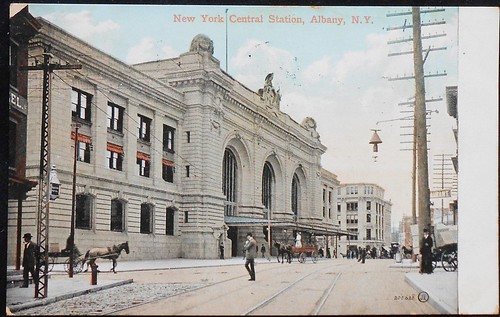
Okay, admittedly, our headline from yesterday was a bit of hyperbole. Of course, the Penn Central Railroad didn’t ruin everything, although it didn’t help many things either. But a commenter noted that they were really just finishing the work the New York Central had started, in the face of the fairly catastrophic decline in both freight and passenger rail service. And while it was convenient that New York State wanted to eliminate tracks and the Maiden Lane Bridge in order to build I-787, that only became a factor in the later ‘60s when the plan for the Riverfront Arterial was final. But it’s true, the situation was all set up nearly 10 years before it happened.
In 1959, the New York Central first proposed moving its passenger station to Rensselaer, and the City of Albany of course immediately opposed it. That caused the railroad, led by President Alfred Perlman, to complain that the city and its business interests had failed to respond to the railroad’s proposals for redevelopment of its riverfront property, including the then-59-year-old Union Station. The railroad argued that economic necessity and a program to streamline operations forced the move, that the Rensselaer station would be more convenient for Albany residents, and that “abandonment of many of its Albany properties will give the city an opportunity to spruce up a rundown section.” Perlman said they would lend their industrial development experts (presumably not the ones who had caused the railroad to be so rundown) to advance a broad urban redevelopment project for the area, which would cover land from Union Station to the river, and north toward the Livingston Avenue Bridge. He even hung out the idea of combining it with a “Title 1” project, a federally aided slum clearance and urban renewal project – the feds would pay two-thirds the cost of acquiring and clearing the area in order to sell it to private interests for redevelopment. But he also said there had been three offers to buy the station from “out-of-town interests” considering the building for office and store use. He also said the Maiden Lane bridge could be converted to vehicular traffic to relieve the burden on the Dunn Memorial.
So here are the detailed reasons they gave in the Knickerbocker News:
Top New York Central Railroad officials say they have to move their Albany passenger station to Rensselaer to meet the economic demands of modern railroading and that no lowering of local taxes could persuade them to change their plans.
These reasons for the move – and reasons why they say they could not locate a new station elsewhere – were outlined by the Central’s president, Alfred E. Perlman; vice president, John F. Nash, and eastern district general manager, Robert D. Timpany:
1 – Union Station is “old, obsolete and too big” and expensive for these days of declining passenger business. The train control system in the station area is obsolete.
2 – A change to a “small, functional station in Rensselaer with just a waiting room and ticket office” would save the railroad $1 million a year.
3 – Taxes are a minor part of the picture. The Central pays the city $59,000 a year on Union Station, Mr. Perlman said, while it expects to save $1 million a year on the move to Rensselaer.
4 – A Rensselaer station, with easier access through traffic and more parking space would be “more convenient” to Albany residents.
5 – The cutback in railroad jobs that would result from the move would not be large.
That Rensselaer would work, and no other location would, was said to be because the railroad already had coach yards, diesel and repair facilities there, and “all we need is a small station building.” A plan for a station in Colonie would run up to $5 million. Perlman got in a little dig at the city, too, saying the $59,000 the railroad paid in taxes “makes up the city’s operating deficit of $57,000 on its airport.” Then, stretching his point and credulity, he argued that the Rensselaer station was really only three city blocks away (assuming you paved over the Hudson). He also said that the move would not discourage rail travel but increase it – that part was even plausible, since parking in Albany was a problem even then.
Mayor Corning, in the same edition of the Knick, said, “Stripping this matter to the bare essentials, all that the New York Central has done is say that it wants to move the railroad station from Albany to Rensselaer. The administration of the City of Albany is opposed to this move, and expects to oppose it before appropriate regulatory bodies. Accordingly, the suggestion of the New York Central – and it is only a suggestion – and any other suggestions for this area are, I believe, premature.”
In 1958 there were already plans to run a new highway along the riverfront. It’s worth noting that just a few years later, in 1962, there were plans and even contracts to build what was called the Riverfront Arterial, which would run from Livingston Avenue to the Yacht Club (and someday south to the Dunn Memorial and north to the Troy-Menands Bridge), filling in the Yacht Club basin to provide parking for 1,000 cars. More on that in the future, but let’s note that the 1962 plan did not call for scrapping any railroad tracks.
Read more on this story:

Leave a Reply